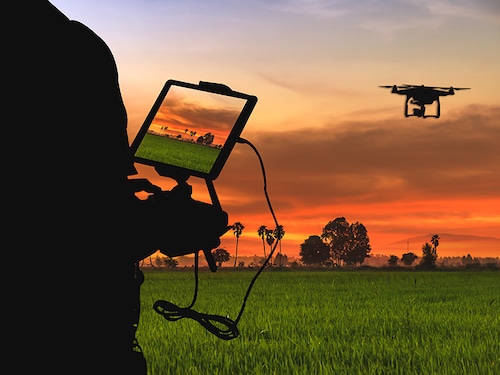An opportune time to digitise agriculture
If Indian agriculture aspires to be globally competitive and viable, the need for digitisation is urgent now more than ever, and can help farmers lower costs, grade better quality and avoid distress s


Agriculture supports nearly half of India’s workforce despite its decreasing contribution to the country’s GDP (85 percent to 16. 5 percent during 1950-2020). Upscaling promising digital solutions across the agricultural value chain can address pressing challenges, posed mainly by the pandemic in the present time and over the long-term by way of climate change and growing population. More importantly, such efforts will leave us with a stronger value chains and means to better welfare. The concern of getting infected with COVID-19 weighs heavily as the farm workforce engages in kharif to feed the country. Mechanising more farms can reduce risk of infection while increasing farm efficiency. Just under 45 percent of Indian farms are mechanised. China and Brazil, India’s associates in BRICS, have managed to mechanise about 57 percent and 75 percent respectively. The US has mechanised 95 percent of its farms.
Digital farms: Workforce, inputs and resources
NABARD attributes India’s relatively low rate of mechanisation to small landholdings, poor access to electricity, credit cost, complicated procedures and low awareness. From driving creation of more Farmer Producer Organisations (FPO) to increasing Kisan Credit Card limits and insurance coverage through Prime Minister Fasal Bima Yojana, a conducive environment has been created to let digital in. Solutions exist for every stage of food production, including use of drones for spraying and minimising human hazard exposure, site and crop-specific nutrient or fertiliser application, soil and water management using IoT sensors, harvest and post-harvest digital solutions with quality assessment and marketing assistance that complement non-digital farm mechanisation and reduce overall human involvement. Low-cost access to capital is the key to the door separating the two sides. Capital support to upscale models like the Uber-style aggregation of farm machinery can bring machines to the farm-gate at affordable costs. The agriculture infrastructure component of Rs 1 lakh crore in the Atmanirbhar package is a first big step in that direction and is expected to set a precedent for more. For governments, incentivising market players, especially start-up communities, to promote quality inputs at competitive prices and conserve natural resources can be an area of focus within the realm of digital agriculture. Fertilizer response ratio in India shows a declining trend due to imbalanced application, lack of awareness, increasing multi-nutrient deficiencies and poor crop management. Remote-sensing, local and drone data can help reverse this trend by accurately identifying plant and soil needs. Digital platforms can facilitate economies of scale by aggregating demand and enabling access to quality inputs at low cost. This will help companies save on supply and distribution costs. While advocating crop diversification, support can also be extended to solutions that attempt to make water-intensive crop production efficient. Such solutions rely on IoT devices to monitor water requirements and enable optimal use. Leveraging satellite derived datasets to accurately estimate water requirements and remotely operating irrigation equipment is another promising area that deserves attention.
Extension and policy
Growing mobile and internet penetration can usher digital in extension services, which are now largely driven through extension officials. Some start-ups have demonstrated impressive results through digital extension via audio and video content, besides SMS in local languages. Many companies are combining datasets such as satellites, drones, weather and local conditions to generate farm specific actionable intelligence. A few companies have also set up call centres to facilitate two-way interaction and are co-opting farmers as co-producers of knowledge. Gaps in internet availability have not deterred solutions. The government can consider actively promoting partnerships between Krishi Vigyan Kendras, FPOs, progressive farmers and startups to scale such services across the country. Such partnerships are also crucial to earn the trust of local farming communities. Mandis haven’t been successful in helping farmers receive more than a fraction of what the consumer pays. That apart, the absence of procurement centres in proximity, high transportation costs and reluctance from mill owners to buy in small quantities remains an obstacle for the realisation of minimum support prices (MSP). There now exist digital interventions to facilitate higher prices for farmers. In addition to traceability, image recognition is being used in quality grading post-harvests, thus removing human subjectivity. As was demonstrated during the lockdown, startups can facilitate aggregation of quality produce and link it to sellers across the country. With information on nearby market prices and MSP, farmers can minimise distress sales. With more encouragement to collectivise small and marginal farmers as FPOs/cooperatives, governments can simplify procurement processes and lower technology access costs. Simplification of FPO reporting processes can lower cost of compliance. With amendments to Essential Commodities Act, 1955, and two central laws on inter-state trading and contract farming, a series of steps have been taken. Meanwhile, enterprises, both established players and startups, need to recognise gaps in digital literacy and develop solutions. The need for digitalisation is now more than ever in Indian agriculture if it has to be globally competitive and viable. Amitabh Kant is CEO and Venugopal Mothkoor is Monitoring and Evaluation Specialist at NITI Aayog. Ram Dhulipala is Theme Leader, Digital agriculture at ICRISAT
First Published: Jul 10, 2020, 12:28
Subscribe Now